.
N - O - P - Q - R - S - T - U - V - W - X - Y - Z
Fire extinction Machine
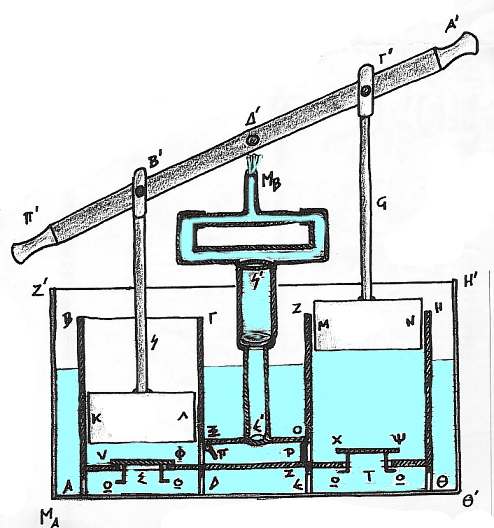
Two Piston Machine for continuous flow of water for fire extinction, probably a work of Ctesibius (c. 250 BC) that Hero improved., image from the Greek Newspaper Eleftherotypia
Flame thrower
Meanwhile the Boeotians at once sent for darters and slingers from the Malian Gulf, and with two thousand Corinthian heavy infantry who had joined them after the battle, the Peloponnesian garrison which had evacuated Nisaea, and some Megarians with them, marched against Delium, and attacked the fort, and after divers efforts finally succeeded in taking it by an engine of the following description. They sawed in two and scooped out a great beam from end to end, and fitting it nicely together again like a pipe, hung by chains a cauldron at one extremity, with which communicated an iron tube projecting from the beam, which was itself in great part plated with iron. This they brought up from a distance upon carts to the part of the wall principally composed of vines and timber, and when it was near, inserted huge bellows into their end of the beam and blew with them. The blast passing closely confined into the cauldron, which was filled with lighted coals, sulphur and pitch, made a great blaze, and set fire to the wall, which soon became untenable for its defenders, who left it and fled; and in this way the fort was taken. Thucydides, Book IV of the Peloponnesian War
Fire was used in antiquity as a weapon. The use of incendiary arrows by the Greeks is reported in the Peloponessian war in 429 BC and in the siege of Rhodes around 304 BC. Around 424 BC Boetians use flame thrower against wooden walls of Delium. The device is a hollow wooden tube that held a cauldron of burning sulphur, charcoal, and pitch at one end. On the temple of Pergamum there were some glyphs showing Hecate and Phoebe holding a weapon against a Giant like a long tube with fire coming from the front side (in this case it is a torch as Klytios the giant was killed by a rain of burning torches from Hecate). These sculptures are in the archaeological museum of Berlin. Historians say that the flamethrower range was only 5 meter but this was enough if ships in a naval action come close together or for setting fire to the wooden siege engines of the enemy.
Aineias c. 360 BC describes the the production of pots filled with a mixture of sulphur, pitch and other materials. These burning pots were thrown on the decks of the enemy ships (similar devices, pots with a burning material, was probably used by Assyrians in the 9th century BC but not against ships).

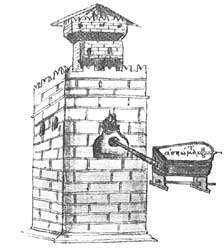
Flamethrower models a) According to Thucydides (ancient), b) Heron of Byzantium (medieval)
A flamethrower using powdered coal is described the the Greek Architect Apollodorus of Damascus (the architect of Hadrian) that can be used against stone walls. The fire is directed against the wall and then a acid mixture is poured on the wall. The effect is that the stone cracks.
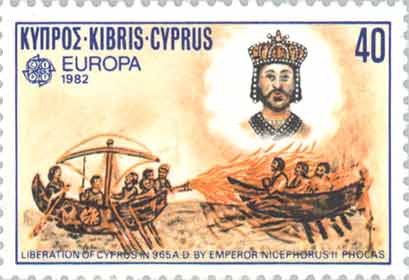
Liberation of Cyprus by the Byzantine Emperor Nicephorus II Phocas
Much more effective was the Greek Fire or Sea Fire (pyr thalassion) that was used on ships like the dromone and that was used for example to destroy two large Arab fleets, but this invention is a byzantine invention. A Syrian engineer Kallinikos (or Callinicus) of Heliopolis is assumed to be the inventor of Greek Fire around 673 AD.
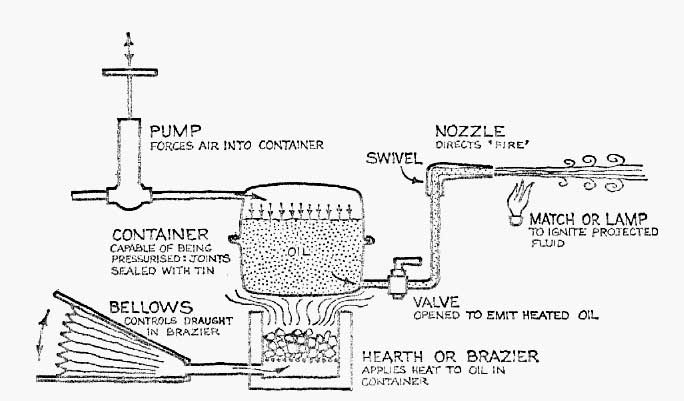
J. H Haldon, M. Byrne, A possible solution of the Greek Fire
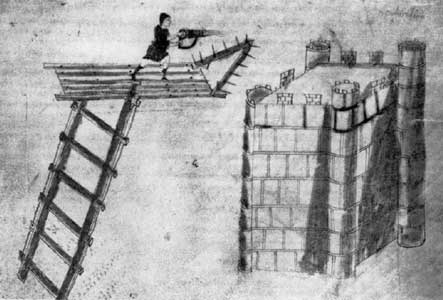
Greek Fire, using a Cheirosifon, Heron of Byzantium
Greek fire was called by the Greeks pyr thalassion ("sea-fire")
A flamethrower model produced by Apollodorus used to destroy walls (from Thucydides mentioned it was used even until the 10th century AD)
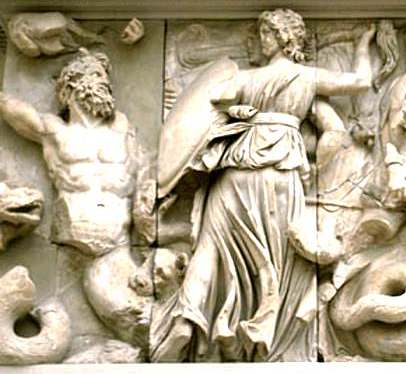
Hecate with the three heads and her dog attack the giant Klytios in the Gigantomachy (See more images from the Pergamon Zeus Altar)
Information about Flame thrower and Greek Fire translated into English from a Russian Website
The so-called Greek Fire is a Byzantine invention: Kallinikos was said to be the inventor of the liquid fire that saved Constantinople from the Arabs in 678 and from the Rus in 941.Its exact composition and means of propulsion are still uncertain, especially since the term "Greek fire" was used to refer to various types of incendiary weapons. The most likely ingredient included crude oil obtained from regions east of the Azov Sea or from wells east of Armenia, mixed with resin and sulphur, which was then heated and propelled by a pump (siphon) through a bronze tube (strepton). The liquid jet was ignited either as it left the tube or by flaming projectiles fired after it. The Byzantines were careful never to divulge details on the composition or propulsion of Greek fire; thus even when the Bulgars captured a great supply of thew mixture and firing tubes they were unable to use them Byzantine Warfare
Floating Bricks
The 1911 Britannica Encyclopedia edition
Floating Bricks were first mentioned by Strabo, the Greek geographer, and afterwards by Pliny as being made at Pitane in the Troad. The secret of their manufacture was lost for many centuries, but was rediscovered in 1791 by Fabroni, an Italian, who made them from the fossil meal (diatomaceous earth) found in Tuscany.
(Greek or Roman invention)
Floating Bridge (Pontoon Bridge)
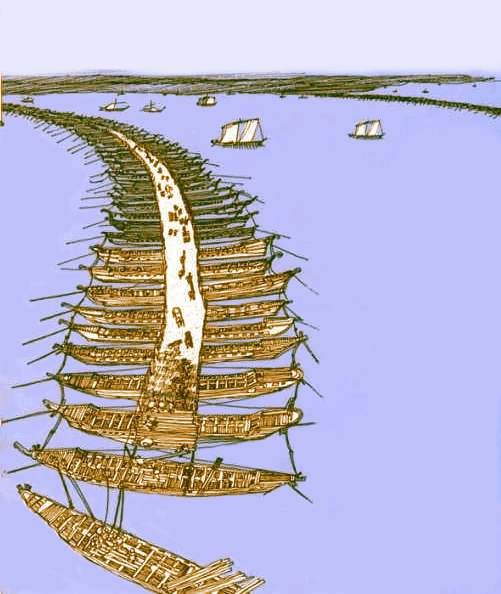
One of the two Xerxes bridges who were constructed with 360 and 314 ships respectively
Floating bridge (Bosporus) produced by Mandrocles of Samos (Μανδροκλής) for the Persian King Darius (513 BC for the expedition against the Scythes and 490 BC). Harpalos of Samos, constructed a two ship rows floating bridge (Hellespont) for the Persian King Xerxes (480 BC). The story of the Bosporus bridge, which accorded a Persian army of 700 thousand safe passage, is as follows (Herodotus):
So Darius, when he had beheld the Pontus, sailed back to the bridge, whose architect Mandrocles the Samian came to be, and having beheld the Bosporus, he stood two pillars by it of white stone, after he had had cut in with letters, into the one Assyrian and into the other Greek, all the very nations that he led and he led all that he ruled. Of those myriads were numbered out, apart from the fleet, seventy with horsemen and six hundred ships were gathered together. Now, those pillars, when the Byzantines had conveyed them to their city, later than that they used for the altar of Orthosian Artemis, except for one stone, and that was left behind beside Dionysus’ temple in Byzantium full of Assyrian letters. Moreover, in the Bosporus that place that King Darius had bridged, so far as it seems to me when I reckon, is in the middle between Byzantium and the shrine by the mouth. Then Darius, having taken pleasure in the bridge of boats, its architect, Mandrocles the Samian, presented with “ten of everything”. From the first-fruits of those it was Mandrocles had painted as pictures the whole bridging of the Bosporus, King Darius’s sitting down on his front seat and his army’s stepping across and, having had that painted, made a dedication in the temple of Hera with this inscription:
Fishy Bosporus on bridging, dedicated
Mandrocles to Hera pontoon’s monument,
Since on himself crown he put, on Samians fame,
By acting wholly with King Darius’ mind.
Now, those proved monuments of him who threw the bridge and Darius, having given Mandrocles a present, crossed over to Europe, after he had announced to the Ionians they should sail into the Pontus up to the Ister river and, whenever they came to the Ister, there they should wait for him while they bridged the river. For indeed the Ionians, the Aeolians and the Hellespontians were leading the fleet. Indeed the naval army, having sailed through and out of the Cyaneae, set sail straight to the Ister and, having sailed up river two days’ sailing from the sea, the river’s neck, from which the mouths of the Ister are split, it bridged. Then Darius, when he had crossed over the Bosporus along the pontoon, made his way through Thrace and, having come to the Tearus river’s springs, encamped three days.
Information for the Xerxes bridge from http://www.oldnewspublishing.com/xerxes.htm
Xerxes called a temporary halt when his army reached the stormy straits of the Dardanelles, at the mouth of the Black Sea. To transport his army across the mile-wide waterway, Xerxes sent hundreds of ships from his fleet into the channel, where they were tied together with thick ropes to create a floating bridge. A violent storm destroyed this bridge before the Persian army was able to cross it.
Enraged, Xerxes ordered that the waters of the Dardanelles be whipped and branded with hot irons. The soldiers sent to perform this symbolic act of punishment recited the following royal proclamation:
"O vile waterway! Xerxes lays on you this punishment because you have offended him, although he has done you no wrong! The great king Xerxes will cross you even without your permission, for you are a treacherous and foul river!"
Xerxes also put to death the engineers responsible for building the bridge. He then recruited a second team of bridge-builders, who cleverly decided to build two floating bridges, one for the use of the army's troops, and a second, downstream, which would carry the large herds of horses and other animals across the straits. The engineers also made sure to use thicker ropes to tie the ships together. After the ropes were pulled taut by giant windlasses anchored to either shore, mile-long embankments of timber, stone and packed earth were laid across the ships' decks to form roadways.
In the weeks that it took to assemble the floating bridges, Xerxes ordered his naval commanders to allow grain-ships bound for Greece to pass through the Dardanelles unharmed.
Bridges in Ancient and Modern Greece
Chronology of Bridges
Flying machines
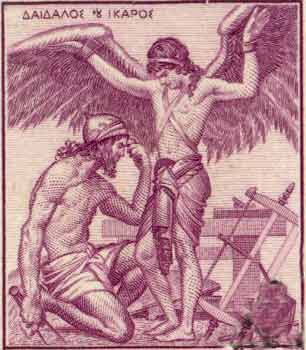
989 BC. Daedalus and his nephew Talus invent the saw, the turning-lath, the wimble, the chipax, and other instruments of Carpenters and Joyners, and thereby give a beginning to those Arts in Europe. Daedalus also invented the making of Statues with their feet asunder, as if they walked. Sir Isaac Newton, A short chronicle: From the First Memory of things in Europe to the Conquest of Persia by Alexander the Great
"Among the credulous the significance of the name of a people of Asia Minor, the Capnobates, 'those who travel by smoke,' gave rise to the assertion that Montgolfier was not first in the field--or rather in the air--since surely this people must have been responsible for the first hot-air balloons. Far less questionable is the legend of Icarus, for here it is possible to trace a foundation of fact in the story. Such a tribe as Daedalus governed could have had hardly any knowledge of the rudiments of science, and even their ruler, seeing how easy it is for birds to sustain themselves in the air, might be excused for believing that he, if he fashioned wings for himself, could use them. In that belief, let it be assumed, Daedalus made his wings; the boy, Icarus, learning that his father had determined on an attempt at flight secured the wings and fastened them to his own shoulders. A cliff seemed the likeliest place for a 'take-off,' and Icarus leaped from the cliff edge only to find that the possession of wings was not enough to assure flight to a human being. The sea that to this day bears his name witnesses that he made the attempt and perished by it. Charles Vivian, A History of Aeronautics
Ovid describes the flight of Daedalus and Icarus: "Some fisherman, perhaps plying with his quivering rod, some shepherd leaning on his staff, or a peasant bent over his plough handle caught sight of them as they flew past and stood stock still in astonishment, believing that these creatures who could fly through the air must be gods." According to ancient legend Daedalus and Icarus escaped on waxen wings from Minoan Crete. It is difficult to believe that there is some truth in this story even if in 23 April 1988 a human powered flying vehicle (called Daedalus!) with Kanellos Kanellopoulos as cyclist pilot, covered the 118 km distance from Crete to Santorini in 3 hours and 54 minutes. But sound authority holds that Archytas of Tarentum, around 425 BC, experimented with kites and toy flying machines, including a wooden dove that flew by "the secret blowing of air enclosed inside," perhaps a primitive compressed-air mechanism. The pigeon in one of the experiments was able to fly 200 meters! Archytas of Tarentum was a Greek mathematician, political leader and philosopher, active in the first half of the fourth century BC (i.e., during Plato's lifetime).

The MIT Daedalus flying vehicle
The only mechanical device that can with some probability be assigned to Archytas, apart from the children's toy known as a “clapper” is an automaton in the form of a wooden bird connected to a pulley and counterweight, which “flew” up from a lower perch to a higher one, when set in motion by a puff of air. The complicating factor here is that Diogenes Laertius reports that there was a book on mechanics in circulation, which some thought to be by a different Archytas, so that it is possible that the flying dove is, in fact, the work of a separate Archytas.
Reference: Stanford Encyclopedia of Philosophy
On The Wings of Mythology Once again a Greek flies from Crete under his own power from TIME Journal
LINKS
Pausanias in his description of Greece does not believe the story of Icarus and Daedalus and assumes that Daedalus invented the sail for the ships (which are the wings of the ship)
For when he was fleeing from Crete in small vessels which he had made for himself and his son Icarus, he devised for the ships sails, an invention as yet unknown to the men of those times, so as to take advantage of a favorable wind and outsail the oared fleet of Minos. Daedalus himself was saved, but the ship of Icarus is said to have overturned, as he was a clumsy helmsman. The drowned man was carried ashore by the current to the island, then without a name, that lies off Samos. Heracles came across the body and recognized it, giving it burial where even to-day a small mound still stands to Icarus on a promontory jutting out into the Aegean. After this Icarus are named both the island and the sea around it.

Kite flying, young girl, 4th c. BC
A - B - C - D - E - F - G - H - I- J - K - L - M -
N - O - P - Q - R - S - T - U - V - W - X - Y - Z
| Ancient Greece
Science, Technology , Medicine , Warfare, , Biographies , Life , Cities/Places/Maps , Arts , Literature , Philosophy ,Olympics, Mythology , History , Images Medieval Greece / Byzantine Empire Science, Technology, Arts, , Warfare , Literature, Biographies, Icons, History Modern Greece Cities, Islands, Regions, Fauna/Flora ,Biographies , History , Warfare, Science/Technology, Literature, Music , Arts , Film/Actors , Sport , Fashion --- |

